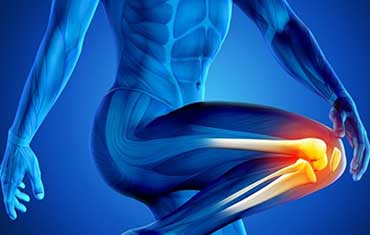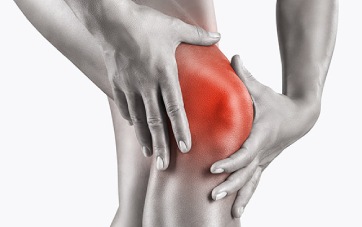KNEE PAIN TREATMENT IN JAIPUR

Pain is a common knee problem that can originate in any of the bony structures i.e. knee joint (femur, tibia, fibula), the kneecap (patella), or the ligaments, tendons, and cartilage, meniscus of the knee. Since it is a weight-bearing joint, Knee pain can be aggravated by physical activity and obesity, affected by the
surrounding muscles and their movements, and be triggered by other problems (such as hip or foot injury) that can mostly be solved by knee pain treatment. Knee pain can affect people of all ages, and home remedies can be helpful unless it becomes severe. If it is serious, consult Dr. Sanjeev, Specialists of Knee pain Treatment in jaipur.
Common Causes of Knee Pain:
1. Knee Osteoarthritis or "Gathiya": This is the most common disease of knee joint. In osteoarthritis of the knee joint, there is age related wear-and-tear of joint cartilage, causing further damage to meniscus and ligaments. It usually happens after age 50 years but nowadays it is seen as early as 35 years age due to prolonged sitting jobs, heredity, repeated injuries in some cases.Symptoms:
a. Dull aching pain on inner side of knee joint.b. Swelling, Feeling of warmth in knee joint.
c. Cracking or grating sound during the movement or walking.
d. Pain increases with activity/walking and relieves with rest.
e. Stiffness in the knee, particularly in the morning or during an extended period of rest.
f. Decrease in the mobility of the knee, making it increasingly difficult to get in and out of chairs or cars, use the stairs, or walk.
2. Rheumatoid arthritis of knee joint or "Gathiya baay": In various types of inflammatory arthritis e.g. rheumatoid arthritis, knee involvement results in diffuse swelling, warmness, pain, limping or difficulty in walking. It occurs due to pannus formation or inflammatory gramuloma formation within the cartilage of the knee joint. Overall control of disease with DMARDs medicines, helps in knee pain, but sometimes it requires Knee joint aspiration followed by anti-inflammatory medicine injection within the joint for the knee pain treatment.
3. Knee Ligament Injury: There are various ligaments around the knee joint, which helps in providing stability to the joint. Anterior cruciate ligament ACL is most commonlyinjured during sporting activities e.g. running, jumping, playing hockey, football or cricket. ACL injury causes knee joint instability and results in rapid damage to cartilage, meniscus of knee, and rapid progression to osteoarthritis. The remaining ligaments (posterior cruciate ligament, lateral collateral ligament, and medial collateral ligament) are injured less frequently.
Symptoms of ACL injury:
a. Feeling of instability while standing, walking, running.
b. History of noisy pop or snapping during activity followed by Dull aching pain or swelling in front of the knee joint.
c. Feeling of knee giving-away.
d. Balance disturbance while walking downstairs, uneven surfaces.
Partial or incomplete ACL tears and complete ACL tears in elderly/ patients with sedentary life-style are treated with US guided regenerative therapy injections into damaged ligament for healing/ ligament regeneration. For complete ACL tears in young or active persons, surgical ligament reconstruction is advised.
4. Meniscal injury or meniscus tear: Menisci are semi-circular structures present within the knee joint that provide cushioning effect or shock absorbing effect within knee joint. During sudden knee twisting movements, these meniscus can get torn and subsequently produce inflammation within the knee joint, and later produce osteoarthritis of knee joint. Medial meniscus is more commonly torn than lateral meniscus. Torn meniscus can give rise to loose bodies, which can cause sudden locking of knee joints in certain positions.
5. Pes Anserine Bursitis: Pes Anserine bursitis is inflammation of bursa or fluid filled sac present between tendons of sartorius, semitendinosus, gracilis muscles and tibial bone. This occurs in overweight persons due to repetitive stress over tendons or due to acute injury.
6. ITB strain or ITB syndrome: Distal ITB or Ilio-tibial band passes over lateral femoral condyle, before inserting over gerdy's tubercle. This tendon may get inflamed by repetitive rubbing of the tendon over bone, causing swelling/ inflammation and pain over the lateral part of knee.
7. Rare causes include:
- Osgood-schlatter disease.
- Patello-femoral pain syndrome PFPS.
- Jumper's knee or patellar tendonitis.
- MCL strain.
- Fractures e.g. tibial plateau fracture, patellar fracture.
- Knee joint stiffness Post knee injury.
- Knee dislocation.
- Knee pain Post-TKR Total knee replacement.
Diagnosis is done by X-ray knee which shows bony abnormalities, fracture, avulsion injury, joint space reduction. MRI knee is done to visualize extent of meniscus injury and ligament tears. Ultrasound evaluation of the knee joint also helps in ruling out multiple soft tissue injuries, muscle or tendon damage, meniscal damage,etc. Also US guided pain relief procedures can be done, targeting exactly the tissue which is affected.
Conditions We Treat
- Headache Treatment
- Neck Pain Treatment
- Facial Pain Treatment
- Shoulder Pain Treatment
- Elbow Pain Treatment
- Wrist or Hand Pain Treatment
- Pain Abdomen Treatment
- Pelvic Pain Treatment
- Upper Back Pain Treatment
- Slip Disc Pain Treatment
- Low Back Pain Treatment
- Knee Pain Treatment
- Heel Pain Treatment
- Neuropathic Pain Treatment
- Sports Injury Treatment


